-

Painting by Wilfredo Lam at the Centre Pompidou
My pleasure. There are more new films not available in the US that are easier to get to than I even expected. I was going to just go to one a day but since my friends aren't in town yet and it was so easy to go to the second one yesterday and today I could not resist. I found the Louis Garrel film by chance. The cinema where it's showing is a bit hidden back behind the famous Café Deux Magots (or is it the Café Flore?) near Satin Germain des Pres, and that was where I first saw Jacque Audiard's THE PROPHET, so I said, let's see what's showing there now? And it was Garrel's LES DEUX AMIS. Paris is always a personal mini film festival for me. I also should go to the reopened Picasso Museum in Paris. It was closed for renovation for years and somebody told me it's really great now. I always go to the Centre Pompidou and the museum has some shows I might like (Karel Appel, Wilfredo Lam) and they have a splendid permanent collection of modern art.

Interior of the Musée Picasso, Paris
Last edited by Chris Knipp; 11-10-2015 at 10:34 AM.
-
JEAN-PAUL RAPPENEAU: FAMILIES/BELLES FAMILLES (2015)
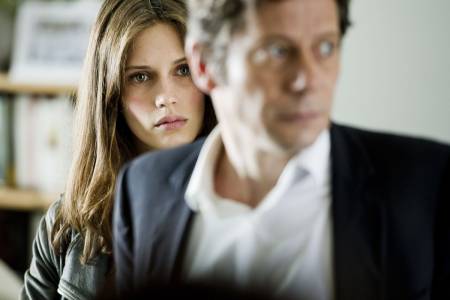
MARINE VACTH AND MATTIEU AMALRIC IN FAMILIES/BELLES FAMILLES
Inheritance ronde
This enjoyable whirlwind is Rappeneau's first directorial effort since his 2003 Bon Voyage (with Isabelle Adjani and Gérard Depardieu); he penned the script of Zazie dans le Métro. He directed the 1990 Cyrano, starring Depardieu, which he co-wrote with Jean-Claude Carrière, with whom he has shared scripting duties before and since. This one has the participation of Matthieu Amalric and André Dusollier, and in his Variety review at its Toronto debut Peter Debruge, linking its plot line quite justifiably with Olivier Assayas' Summer Hours (though the mood and genre of the two films are totally different) says it's the director's most personal film to date. Imagine that. And yet it's nutty, slightly campy fun.
Like one of the characters in Assayas' film, Jérôme Varenne (Amalric) is a banking cosmopolite with Asian connections who has renounced any inheritance of his family's chateau (a much more substantial manse than the one in Summer Hours). But when he stops over in Paris with Chinese girlfriend/collaborator Chen-Lin (Gemma Chan) en route to a big deal in London, he learns of some doings he can't approve of.
Jérôme isn't any too friendly with his brother, Jean-Michel (Guillaume de Tonquedec), and they're literally at each other's throats at the end of a dinner chez maman Suzanne (Nicole Garcia). Poor Chin-Lin, who can't understand French, has no idea what's up, but Jérôme leaves her at the hotel in Paris, and lets her go on to London, while he rushes to the hometown. He has learned the chateau is about to be sold and torn up for for a real estate development in the thriving Loire Valley town of Ambray. Mayor Pierre Cotteret (Dusollier) is sitting on the deal, and there is a missing document.
Rappeneau is referring to something that happened to his own family home, Debruge explains, but this plot is complicated by a tough, social climbing old buddy Grégoire (Gilles Lellouche), whose current girlfriend Louise (Young and Beautiful stunner Marine Vacth, now 24) turns out to be the daughter of Jérôme and Jean-Michel's dad by his mistress, Florence (Karin Viard). And Florence is around. It also turns out that the mayor's secretary Fabienne (Claude Perron) used to be madly in love with Jérôme, and Pierre Cotteret has always been nuts about Suzanne. The pouty, free-spirited (and ethereally lovely) Louise keeps hurting herself and laying about in attractive stages of undress, and she and Jérôme start getting drawn to each other, while later on, after the London deal has crumbled for poor Chin-Lin, Chin-Lin and a handsome Chinese Pianist are drawn to each other. Ooh la la!
Rappeneau shows a mixture of humor and mastery in the way he stages a wonderfully chaotic yet smoothly rhythmic sequence where everybody is running around at a festival concert with the Chinese pianist is playing a Beethoven concerto, and Chin-Lin, who has come to town to find out what kept Jérôme from negotiating a deal he'd worked on for two years and met the pianist at the train station, is the only member of the cast sitting still in the audience, entranced by the handsome pianist. It's at this point that the film justifies the French adverts touting it as a "choral" work. This is music, and everybody plays his or her operatic part, and it all comes right in the end when a certain missing letter is found, Suzanne realizes that her husband's mistress Florence had "class" and the old fashioned snobbish values and traditions of France and of aristocratic "belles familles" are vindicated. The chateau is saved, and daddy Doctor Varenne (Noël Hamann), who reappears from the dead to Jérôme more than once, turns out to be one of those men who loved his mistress more than his wife. Which, this being Rappeneau's dream France, is fine with everybody. Nostalgia, sadness, fantasy, and humor make a confection that is irresistibly silly and fun and well put together.
Belles familles/Families, 113 mins., debuted internationally at Toronto Sept. 2015, opening in French theaters 14 Oct. Allocine press rating a mediocre 3.3. Screened for this review 29 Oct. at UGC Danton, Paris.
Last edited by Chris Knipp; 02-07-2016 at 10:20 PM.
-
PATRICIO GUZMÁN: THE PEARL BUTTON/EL BOTÓN DE NÁCAR (2015)
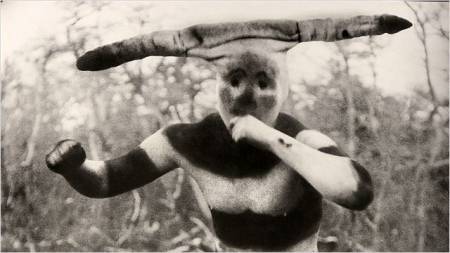
Haunting us and warning us
The Pearl Button/El botón de nácar is another partly soothing, partly disquieting meditation on nature, Chilean history, and man's inhumanity to man from documentary filmmaker Patricio Guzmán. His 2011 Nostalgia for the Light was on my Best Documentary list for that year. It begins with desert, the sky, and moves on to los deaparacidos, the disappeared ones from the Pinochet dictatorship. In his Variety review at Berlin, where it debuted, Jay Weissberg found that this new documentary, whose starting point is water and the sea, is "muddied" by a "Natural Science 101 voiceover" and an inability to meld "two rather disparate subjects." These are the disappeared ones, again, particularly those dropped into the sea by helicopter, and, leading up to them, the indigenous peoples of Chile and Patagonia who were almost completely wiped out by the colonizers. Here we are introduced to the basic information about the five separate seagoing native peoples of Chile and their nearly lost languages, with interviews with a few of the handful of survivors.
However, we should note that while Weissberg has a point about the link between the disappeared ones and the aborigines being a bit vague, the earlier documentary made some broad leaps too. It is Guzmán's style to use broad, poetic musings laced with sonorous truisms about nature as the basis of further musings about human history. His soothing blend of poetic Spanish voiceover, lovely images of nature, and sound, creates a hypnotic mood that soothes us, and then he hits us with tales and images of man's innate cruelty. It works, each time. And despite Weissberg's justifiable reservations this time about two big topics that don't quite fit together in the same film, The Pearl Button won two prizes at Berlin, the Prize of the Ecumenical Jury and the Silver Bear for Best Script. Actually most critics have liked this new film.
What I will take away from The Pearl Button, besides the hypnotic voice and films of sea and snow, are the photographs of the astral images painted on the bodies of indigenous peoples of Chile, who believed that when they died the turned into stars; and the story of Jimmy Button, the native bought from his people for a handful of pearl buttons and taken to England to be turned into a "gentleman." Later he was returned to his native land. He let his hair grow out again and began speaking a mix of English and his native tongue. He could never merge back into his identity. This story of ancient peoples robbed of their culture and land, a few of them surviving like beached whales on an alien coast where they are strangers like Ishi, the last Yahi Indian in California memorably written about by Theodora Kroeber, is one that happens over and over as mankind looses touch with its roots.
The Pearl Button/El botón de nácar, 82 mins., which debuted at Berlin as mentioned, has shown at at least 18 other international festivals, including Toronto and Vancouver. It opened in the US 23 Oct. and France 28 Oct. Despite Wiessberg's valid criticisms of the new film compared to the old one and the general weaknesses of the poetic musings, critics have been pretty pleased. The AlloCiné press rating is an enthusiastic 4.2, and the Metacritic raging is 80%. Screened for this review (as "Le button de nacre") at MK2 Hautefeuille 29 Oct. 2015.
Last edited by Chris Knipp; 11-10-2015 at 10:35 AM.
-
CURRO SÁNCHEZ: PACO DE LUCÍA: LA BÚSQUEDA/PACO DE LUCÍA; LA LÉGENDE (2014)
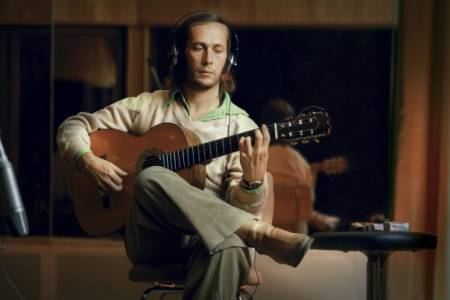
PACO DE LUCÍA
A son's film homage
Paco de Lucia: Legende du flamenco is a documentary about the Spanish guitarist by his son Curro Sánchez (born Francisco Sánchez Varela). Its great virtue is that the music never stops, and some of Paco's more vibrant film performances are generously sampled or even allowed to play out to the end, the film telling the story of the guitarist's triumphant career in his own words and illustrating each stage with archival footage of performances or stills.
Paco is one of Spans most famous musicians of recent times. But we must examine his legend more critically than his son does. He is a primary exponent of the fast and loud adaptation of flamenco that is impressive, and reaches a wide audience, but also to some extent detaches the music from its rich cultural context -- the kind of vibrant excitement you get in an improvised flamenco "juerga," or feel (even if the scenes are more staged) in Carlos Saura's flamenco films. Paco's greatest inspiration and singer collaborator, he explains in life narration filmed by his son, was Camerón de la Isla (Cadíz-born José Monje Cruz,) again a widely known figure in contemporary flamenco music, but one whose smooth stye, though more "musical" and vocally wide-rainging, by the same token lacks a lot of the art form's usual harsh, raucous, passionate, and distinctive Andalusian element. Camerón's 1992 drug-related death at the age of 41 is not mentioned here, though Paco says theirs was more an artistic than a personal union because they were both so shy, Camarón even more "inward" than Paco -- who says at one point he has spent 80% of his life alone, of necessity, as an artist and a composer.
The film is perhaps best in its early part where Paco talks about how he picked up a guitar at seven and outplayed his older brother, about his early touring abroad, and about the inspiration of his impoverished father, who played flamenco guitar in taverns at night for pennies. It would be a distortion to say that Paco de Lucía was the greatest flamenco guitarists of all time, as some glibly do of late. How would we know that? Though he sought at once to transform flamenco and dig into its roots, purists have long disapproved of of his style, which Andrés Segovia said was notable only for its speed. This aspect of Paco de Lucía is only a prominent example of a popularization and dilution of flamenco, which flourished in the mid-19th century and has been fading for a long time, can hardly be blamed on Paco. But it would be nice if this film placed Paco and his brilliant career more firmly in the context of the history of flamenco music and other flamenco guitarists. One place where this does come is in the discussion of Paco's meeting with (and later support by) the earlier flamenco guitar master Sabicas (Agustín Castellón Campos), whom we see play in a film, and who is clearly an even more adept and smooth player than Paco if, perhaps, as noted, without as much passion. We only see one dancer, and hear two singers, and only a couple of flamenco guitarists are highlighted, so this is not a context in which we can evaluate Paco in relation to other players or the art of flamenco as a whole.
Paco's public image was burnished in Spain and abroad by his own band that lasted for 17 years and, notably included the cajón, a box-like percussion instrument traced back to slaves. But the most unique feature of Paco's career is his role in jazz-flamenco crossover through being the central member of the popular, long-lived and much-recorded "Guitar Trio" consisting of Paco, John McLaughlin (of Miles Davis' "Bitches Brew") and Al Coreal, Coreal later replaced by Al Di Meola. Jazz keyboardist Chick Corea was another collaborator. The Trio's" performances, marketed in popular live albums, are marked by resonant, metallic sound, rapid flow, and dazzling improvised riffs in which the three guitarists echo and play off each other. The performances are unified not only by Paco's percussive energy but by his rhythmic precision, noted earlier in the film as one of his most unique features as a musician and something that helped discipline dancers, one of whom he counseled to practice with a metronome. We hear and see an extended playoff of the "Guitar Trio."
These "Guitar Trio" performances may have made flamenco-style guitar virtuosity more well known, but they are more displays of showmanship than profound expressions of either jazz or Spanish music. They made Paco de Lucía world famous, at the cost of homogenizing his music. Nonetheless the film shows his profound dedication as a performer and his rigorous self-criticism, and his connection with flamenco was life-long.
Curro Sánchez's loving documentary, a rich amalgam of the subject's live narration and copious archival footage, was abruptly halted when Paco died of a heart attack at the age of 66. Understandably shocked by this sudden event, the filmmaker-son does not quite know how to end the film, and so the final moments drag on a bit, with yet another fiery live performance interspersed by short mere blips of home movies and stills from various moments of the life.
Paco de Lucía: la búsqueda ("Paco de Lucía: the Search"), 95 mins., debuted 20 Sept. 2014 at the Donostia-San Sebastián International Film Festival, followed by a limited release in Spain. It won the Goya Award for Best Documentary and was nominated for Best New Director and Best Editing. Other fests in 2015 including Miami, Seattle, and Vancouver. French release asPaco de Lucía: légende du flamenco ("Paco de Lucía: Flemenco Legend") was 28 Oct. 2015, French reviews generally favorable (AlloCiné press rating 3.4), though the extended musical scenes met with more favor than the conventional documentary format. Screened for this review 2 Nov. 2015 at Luminor Hotel de Ville, Paris.
Last edited by Chris Knipp; 11-10-2015 at 10:36 AM.
-
PASCALE POUZADOUX: THE FINAL LESSON/LA DERNIÈRE LEÇON (2015)
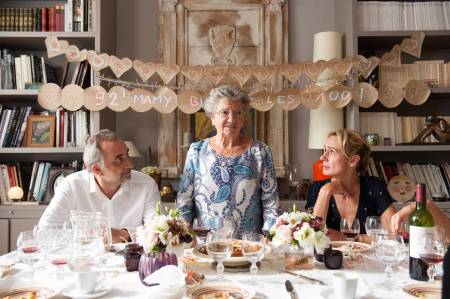
ANTOINE DULERY, MARTHE VILLALONGA, SANDRINE BONNAIRE IN THE FINAL LESSON
Choosing when to die poses problems for others in this French film based on a memoir
In The Final Lessom/La dernière leçon, Pascale Pouzadoux, adapting a book by co-scriptor Laurent de Bartillat, broaches a solemn topic indeed: an elderly woman's decision to end her own life, despite the emotional pain this causes her son, grandson, daughter and others. The subject is the issue of the right to die. This film, based on the true account of a similar experience of Noëlle Châtelet, sister of Lionel Jospin, takes up a profound and troubling theme.
But as dealt with here, it seems, alas, more material for TV drama than serious cinema. In its succession of funny, touching, angry, desperate, and solemn moments, inter-cut with one too many flashbacks and montages, The Final Lesson not only risks banality, but founders, running out of energy and drive before it's halfway through. This despite a brave and splendid turn as the tired-of-life Marguerite by 83-year-old Jewish mother specialist and TV-series vet Marthe Villalonga as well as the always authentic Sandrine Bonnaire as her friend, soulmate, and daughter Diane; Gilles Cohen as Clovis, Diane's supportive and neutral hubby; and Antoine Duléry as Marguerite's son Pierre. Grégoire Montana is touchingly affectionate as Marguerite's loving grandson and surfing enthusiast, Max. But Max as presented is too much the conventional movie mop-head teenager, and Cohen's scenes as a chef are irrelevant, though not as much so as a disposable interlude in which Diane is suddenly carried off on a motorcycle ride and a jog with a handsome male nurse from Marguerite's time in hospital.
The momentum problem is one issue. Another is representing multiple points of view. Too little information is given about Marguerite's life, which it's hinted has been a seriously productive one as a midwife. Flashbacks of her playing in the back yard as a young woman with Diane as a child don't help. The authority and credibility of Villalonga as an actress help a lot, but cannot make up for the fact that we don't know who Marguerite is, other than a stubborn old lady who is overweight, has some trouble walking, and is not very able to cope by herself when she goes back to live in her old apartment. At a celebration of her birthday, Marguerite braves many interruptions to give a speech in which she announces her decision, giving the exact date when she has decided to die. She has concluded that her life is over, and she will only be a burden on herself and others if she goes on longer. She has chosen a time to die, and it is only weeks away. By herself, Marguerite is attended in the daytime by the unbearably lovable earth-mother type Victoria (Sabine Pakora). Victoria is a big lady herself, and a charmer, full of worldly wisdom laid on thick. Victoria makes no judgments, content to sing the occasional lullaby and offer the occasional cuddle.
Left on her own, Marguerite has several disasters. Notably, she falls and can't get up, and the food she had cooking on the stove burns and fills the apartment with smoke. Max and Diane intervene in time, and Marguerite has to spend time in the hospital. There, Pierre insists that she be put on antidepressants, which he thinks will solve the problem. Diane insists her mom isn't at all depressed, just determined. In the next bed is a man incapacitated by a stroke who says that if he could get hold of "the little pill" he'd do away with himself without a thought.
Marguerite herself however must have many a thought, because her family members are so troubled by her decision that she seriously wavers. Her son Pierre, who remains furiously, unrepentantly angry at her, traumatizes her with a nasty visit. Poor Marguerite. But is her decision justified? The filmmakers don't have the severity or bravery to convince us of that, and in this their treatment is too superficial. Someone with the courage and gravitas of Michael Haneke in Amour would need to take on the subject. Here there are many Hallmark moments and a good number of jokey ones, but the overall impression remains at once grim and unsatisfying.
The Final Lessom/La dernière leçon, 105 mins., debuted as the Festival du Film Francophone d'Angoulême in August, also showing at Busan in October. It opened theatrically in France 4 November 2015. Screened for this review on that day at UGC Danton, Paris. Local reviews were mediocre, though not terrible (AlloCiné press rating 3.2 based on 10 reviews).
Last edited by Chris Knipp; 02-07-2016 at 10:12 PM.
-
KHEIRON: NOUS TROIS OU RIEN/ALL THREE OF US OR NOTHING (2015)
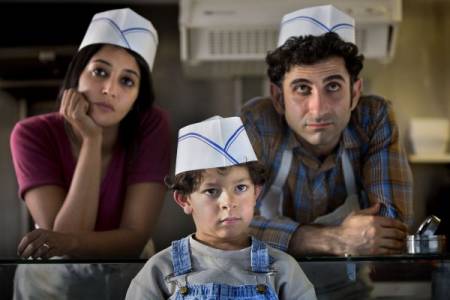
KHEIRON, LEÏLA BEKHTI IN NOUS TROIS OU RIEN
A serio-comic homage to Iranian parents
In Nous trois ou rien French Iranian descent standup comic Kheiron, known from Jamel Comedy Club and the Canal+ TV mini-series "Bref," directs and stars in his first film, a recreation of his parents' lives as a popular family epic interspersed with running comic elements. Hibat (Kheiron himself playing is father) and Fereshteh (Leïla Bekhti), who eventually wind up in a Paris banlieue winning honors for community work, are an Iranian lawyer (but without degree--because he's been held in jail for anti-Shah activity) and a nurse he meets after he gets out of prison and quickly and joyously marries. The couple's decision to leave the country and take their shared revolutionary ideas to a new land comes after the Shah's dictatorship has been followed by the Ayatollah Khomeini's worse one. The film is in two halves, Iran and France, the second half being more specific and colorful and the first more idealized and conventional.
Nous trois ou rien has won enthusiastic praise for its revolutionary sentiment and its liberal populism. But though it's a lively tale of liberal democratic ideals transposed to a new country, the film did not work well for me, for several reasons. First of all, though the seventies Iranian settings look authentic enough, everybody in the Iran scenes speaks French. Second, despite what are surely the best of intentions, Kheiron's mixture of comedy with the grim experiences of two brutal Iranian regimes and a heroic and terrifying escape from the country necessarily leads to further wrong notes.
The second half finds Kheiron at least in familiar territory, since he grew up with his parents in France. (They also later bring over her parents (played by Gerard Darmon and Zabou Breitman; his family's many members are not followed up on as closely.) The Iranian part he has to imagine, and tends to feel more generic. Some of it, such as the prison experience and Hibat's brutal beatings and solitary confinement for refusing to eat cake in prison to "celebrate" the Shah's birthday, and later the young couple's escape from Iran to Istanbul across an awesomely limitless mountainous landscape, isn't remotely funny or meant to be. Yet the film begins with a jocular presentation of Hibat's family of twelve siblings, and includes absurd scenes of the Shah himself broadly played by comic actor Alexandre Astier reprising his turn as King Arthur in the French TV series "Kaamelott."
As things become challenging rather than life-threatening once the couple are in France, things move faster and the tone becomes easier to keep consistently light; but it's, obviously, impossible to show the couple struggling with French, as Audiard so convincingly does in his Dheepan, given that Kheiron has his parents and everybody else speaking fluent French from the first frame of the movie. On the other hand, Kheiron's depiction of the couple's energetic social work within their adopted cité of Stains is a welcomely positive focus on finding solutions and building multicultural integration in the banlieue rather than using that setting, as is more frequent, as a location for crime or action movies.
It may seem unsporting of me to point out this movie's obvious shortcomings. After all, Nous trois ou rien is a homage to the filmmaker's parents that's as warm-hearted as it is evidently well-deserved. But you have to cut this movie a heck of a lot of slack to see it as a success in artistic terms. Comparisons to Marjane Satrapi 's graphic novels and her filming of them with Vincent Paronnaud are likely, but even her successes have varied. Her film realization of the dry, politically accurate early one Persepolis, works much better than the second more fanciful and saccharine Chicken with Plums. Arguably Kheiron is trying to do something harder than Satrapi is in representing Iranian realities and trying to keep it (sometimes) light in a regular feature film. But Satrapi is also luckier and wiser in Persepolis in keeping the grimmer experiences of her family in the background.
Hibat, as embodied by Kheiron, is a tidy little guy with an attache case at the cité, now winning the confidence of banlieue tough guys and turning their lives in a positive direction when they learn he's done far more jail time than they have and was beaten for refusing to eat cake. He is almost a different person from the heroic struggler in Iran, and this second part seems like a different movie, probably one more truly suited to the actor/filmmaker/writer's talents.
Nous trois ou rien ("All Three of Us or Noting"), 105 mins., debuted at Tokyo in competition in September 2015, wining the Best Director prize there. It opened in French theaters 4 Nov. to generally positive reviews (AlloCiné press rating 3.6; but Les Inrockuptibles, Cahiers, Libération and L'Humanité did not review it and Le Monde and Le Nouvel Observateur were unfavorable). Screened for this review at Gaumont Opéra côté Capucines Paris 5 Nov.

KHEIRON, GÉRARD DARMON, LEÏLA BEKHTI, ZABOU BREITMAN IN NOUS TROIS OU RIEN
Last edited by Chris Knipp; 11-11-2015 at 05:36 PM.
 Posting Permissions
Posting Permissions
- You may not post new threads
- You may not post replies
- You may not post attachments
- You may not edit your posts
-
Forum Rules






 Reply With Quote
Reply With Quote






Bookmarks